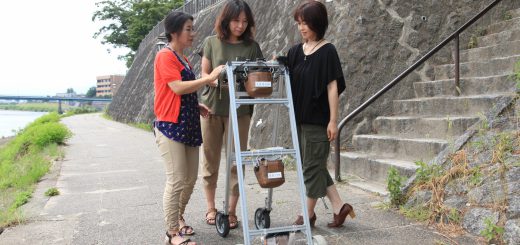Anti-Nuke Who’s Who / The Association for the Preservation of Nagashima’s Nature – a group with a mission to protect the “Ultimate Paradise” Nuke Info Tokyo No. 84
The Association for the Preservation of Nagashima’s Nature:
A group with a mission to protect the “Ultimate Paradise”
By Midori Takashima (Representative of the Association)
The Association for the Preservation of Nagashima’s Nature was founded on 29 September 1999, and currently has about 150 members. It is an environmental organization set up to protect the natural environment of Nagashima, the planned site for Kaminoseki nuclear plant, which has a unique ecosystem and natural riches that are worth the world’s attention. The organization has conducted joint studies with groups of experts from societies such as the Ecological Society of Japan. It also holds public functions and gatherings in the interest of citizens and sells products illustrating the rare species of the area.
‘The ultimate paradise’ is the nickname scientists have given to the proposed Kaminoseki site in Nagashima. The area has three main features.
 |
 |
|
| Fig.1 Yashimaishin (Tomura cf. yashima) |
Fig. 2 Sunameri (Neophocaena phocaenoides)
|
|
 |
 |
|
| Fig. 3 Peregrine Falcons (Falco peregrinus, Hayabusa in Japanese) Source: www.gfnet.co.jp/~dive/hayabusa.html |
Fig. 4 Namekujiuo (Branchiostoma belcheri)
|
1. It is a treasure house of rare creatures:
(i) Species of world significance such as the Yashimaishin (a type of mollusc) live there (Fig. 1. – All figures except Fig. 3 provided by the Association for the Preservation of Nagashima’s Nature.). These shell creatures hold the key to understanding the evolution of the snail.
(ii) In comparison to the fact that the number of Sunameri (the smallest whale in the world) living in the Setonaikai (Seto Inland Sea, see maps in p.10) is now only 15% of what it was 20 years ago, the area that would be affected by the construction of a nuclear power plant at Kaminoseki is the only area where Sunameri has not only maintained its numbers but rears its young (Fig. 2). This whale is classified as a protected species by the Ministry of Environment.
(iii) By the beginning of the 1990s, there were only 200-300 pairs of Peregrine Falcons in the whole of Japan (Fig. 3). Peregrine Falcons nest and breed in this area.
(iv) After 1980, the Ariakekai (Ariake Sea) and Aichi Prefecture were the only places where Namekujiuo (a fish listed as endangered by the Fisheries Agency) had been sighted (Fig. 4). This chordate breeds in this area.
 |
|
Fig. 5 Amakusaumikochou (Gastropteron bicornutum)
|
2. Due to the Black Tide flowing from the Bungo Channel, many warm-current and ocean species, including Amakusaumikochou (a type of mollusc), are living in this area (Fig. 5).
3. In this area, 75% of the seashore has been maintained in its natural state (cf. Yamaguchi Prefecture as a whole, 23%; and the Seto Inland Sea as a whole, 21%). Village laurel forests are in good condition. Overall, the natural environment has remained largely undisturbed.
Chugoku Electric’s Environmental Impact Assessment (Preliminary Paper) of the area, submitted to the former Ministry of International Trade and Industry (MITI) on 27 April 1999, was criticized for the following elementary oversights:
(i) It did not mention Sunameri or Namekujiuo;
(ii) It said nothing about the Peregrine Falcon, other than that they have been seen flying in the area;
(iii) It overlooked rare shell species.
Supported by the Yamaguchi Prefectural Governor and the Director of the former Environment Agency, the MITI took the unprecedented step of advising Chugoku Electric to undertake a supplementary investigation. However, the supplementary report of 18 October 2000 (Interim Report) concluded, without any scientific justification, that ‘the impact on the environment will be small’. Then, without adequate deliberation, the MITI and Yamaguchi Prefecture made it clear that they ‘basically accept the interim report’. The supplementary investigation was a ceremony for ‘fitting geta sandals to a failure’*.
At its 2000 meeting, and again at its 2001 gathering, the Ecological Society of Japan passed a motion calling for the assessment to be done afresh. The Association for the Preservation of Nagashima’s Nature is also appealing to the administration and spreading the word about Nagashima’s natural environment and ecosystem. The association has been building interest and support throughout Japan and internationally through such activities as joint studies with scientists, a tour of inspection for an inter-party group of parliamentarians (see p.11) and by networking with a wide range of environment groups. The question is this: will we stop the first new nuclear industrial development of the 21st century, and leave to the children of the future the incalculable benefits of this wonderful ecosystem – something which we can be proud of – or will we leave behind the burden of living in fear of nuclear after-effects? Our responsibility to the children of the future is great indeed.
* This is a Japanese proverb which means, to raise the marks of a failed student so that s/he can pass, just as putting sandals on increases a person’s apparent height.

